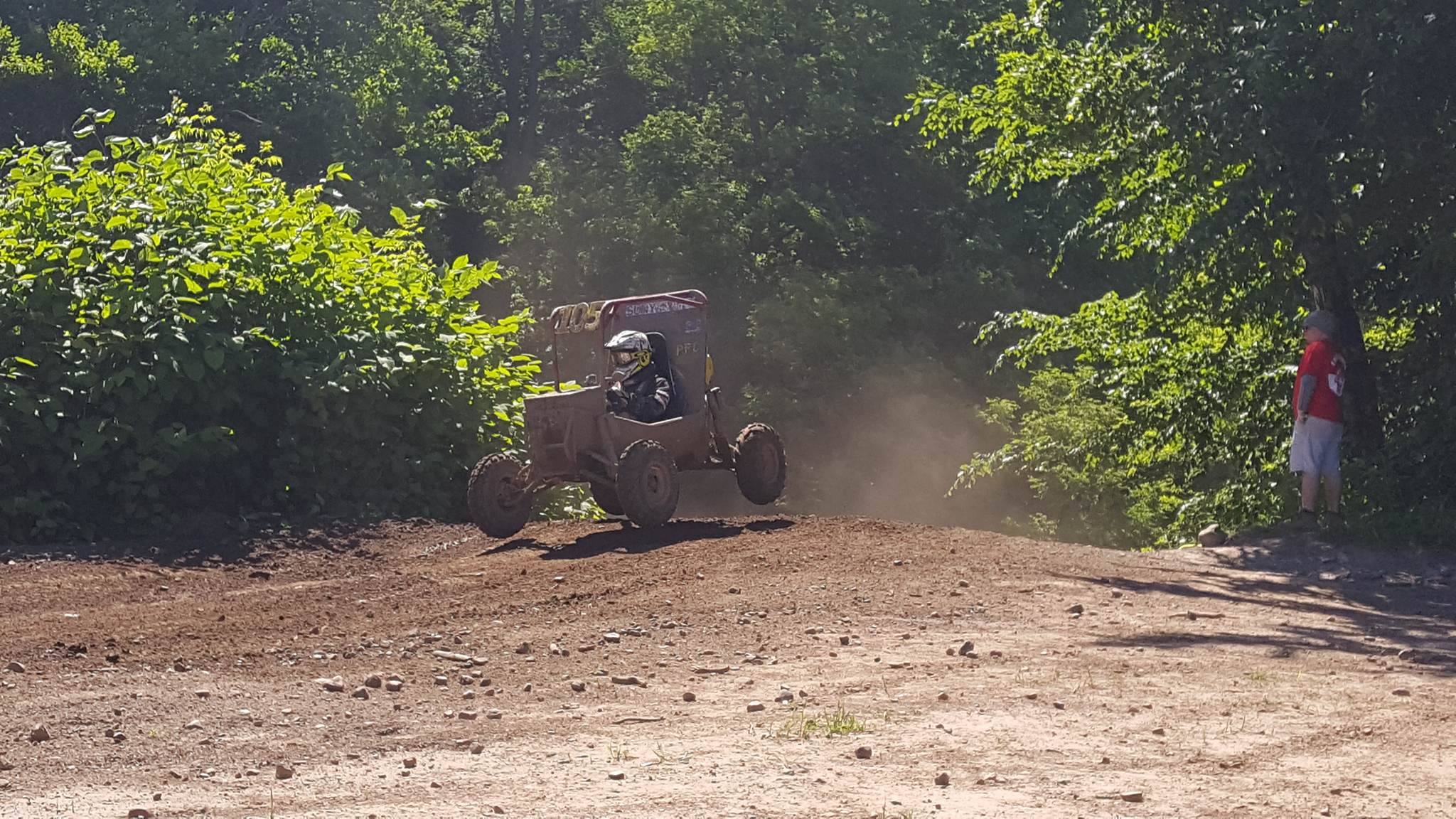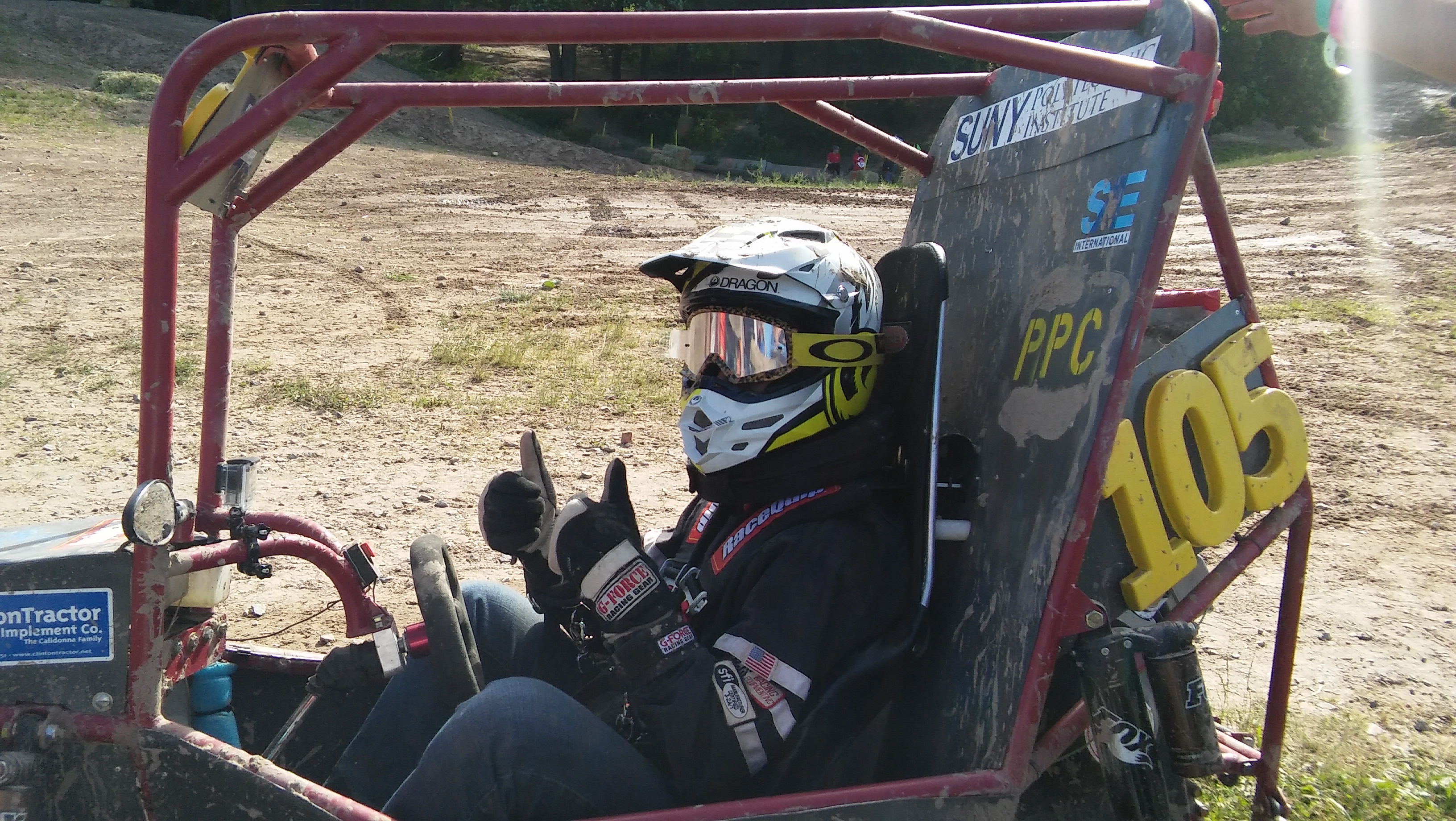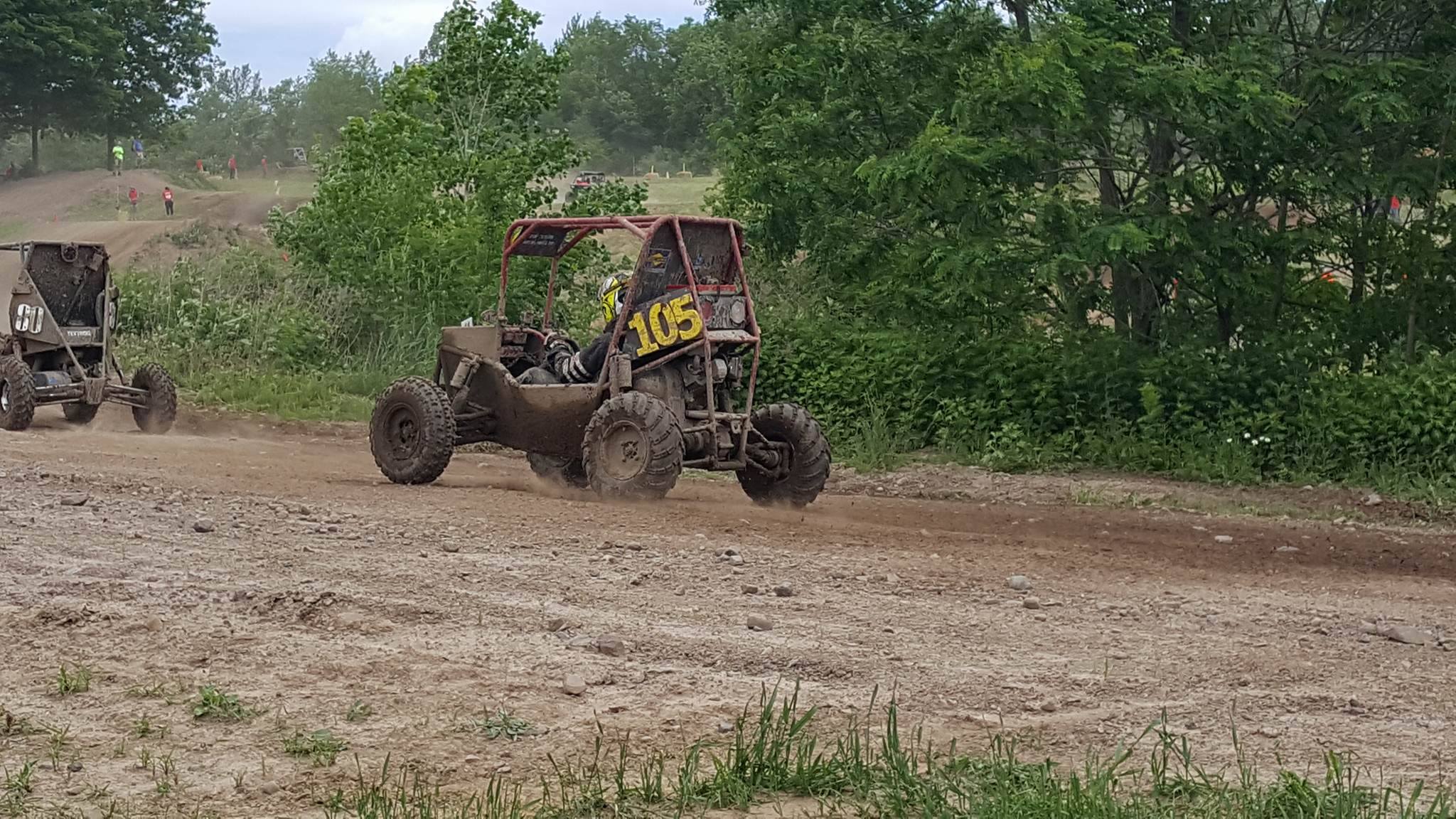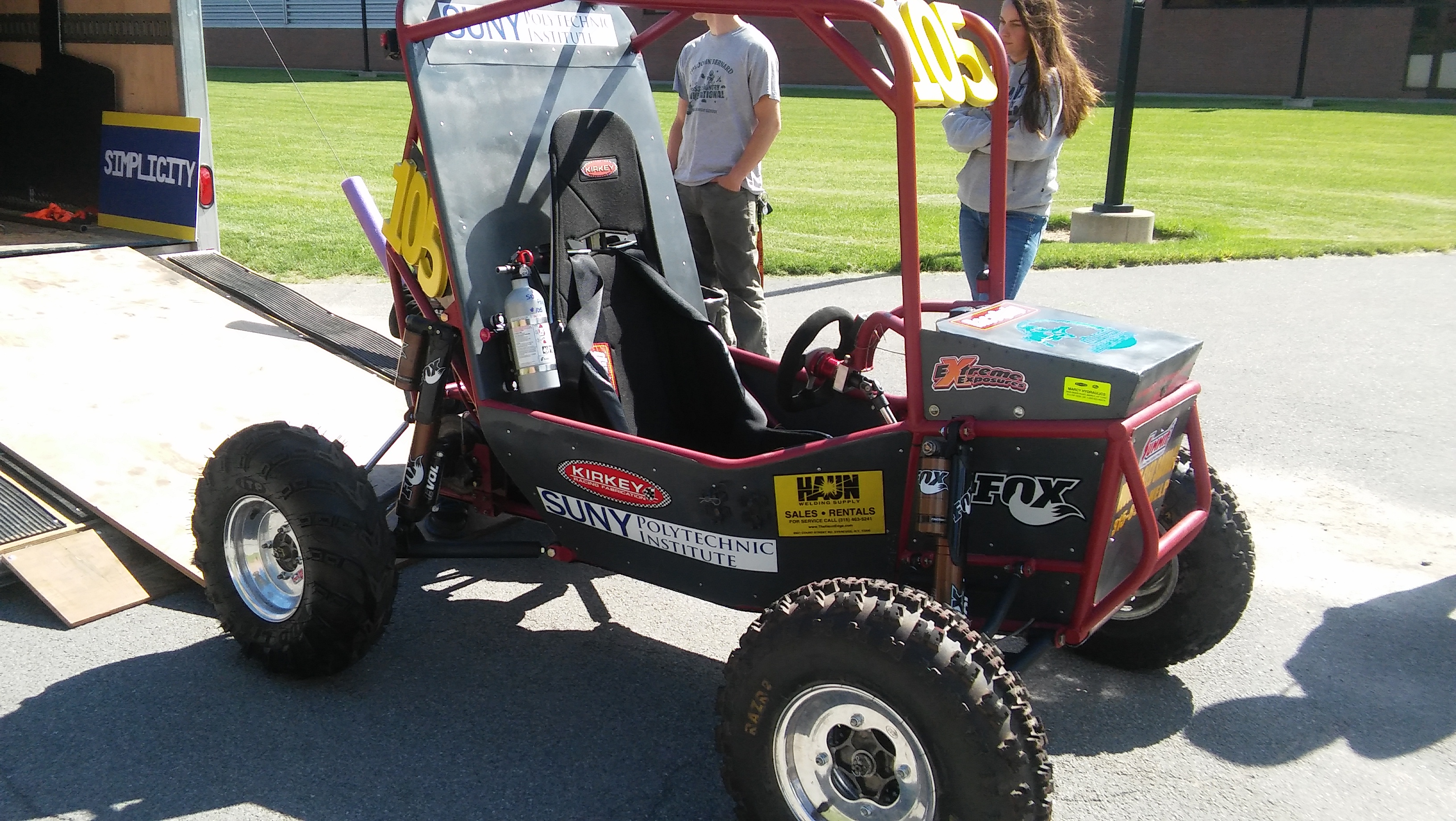SUNY Poly Baja Club Sets School Record
by Kiersten Albertson, Secretary for the SUNY Poly Baja Club

The SUNY Poly Baja Club placed 25 out of 95 teams that attended the Rochester 2016 Baja SAE International Competition.
SUNY Poly’s Baja SAE team has typically been one of the larger, well known, student run clubs at SUNY Poly’s Utica campus. The team consists of students who are most often enrolled in a mechanical engineering technology or mechanical engineering program, but all students are welcome to join. Baja is a student competition organized by the Society of Automotive Engineers (SAE). The students design, fabricate, and test an off road vehicle (a buggy if you will) capable of withstanding a variety of physical obstacle courses over the course of four days.
The students involved in their school’s club or organization have the opportunity to compete in up to three SAE collegiate design competitions held in three different locations. Usually a larger university hosts the competition on their campus, at an off campus site, or both. This year, SUNY Poly’s Baja team chose to participate in a competition hosted by RIT which included 94 other universities from around the country and world. RIT hosted half of the competition on their school’s campus and the other half was hosted at Hogback Hill in Palmyra, NY.

The SUNY Poly Baja Club placed 25 out of 95 teams that attended the Rochester 2016 Baja SAE International Competition.
Each competition site has the option of hosting different dynamic events as well as required static events. Teams are able to earn points from both the static and dynamic events and the goal is to get as many points as possible. SUNY Poly’s Baja team arrived on RIT’s campus June 9th this year to begin this series of four days’ worth of events. The first two days encompass all of the static events which includes a variety of technical inspections and presentations to ensure the practicality of the car’s design as well as its safety and functionality. These inspections also verify that all teams have followed the SAE rule book to promote a fair competition. A team is required to pass an engine check and a technical inspection before they are allowed to drive their car on any competition site.
In between each inspection, teams deliver both a design presentation and a sales presentation. The design presentation is used to evaluate and explain the reasoning behind each design decision made by each team for each mechanical component of the car. The sales presentation is used for students to convince the judges why a company should by their vehicle. This focuses more on business and is where a lot of teams involve business majors in their club.

The SUNY Poly Baja Club placed 25 out of 95 teams that attended the Rochester 2016 Baja SAE International Competition.
After all static events are successfully completed, teams can enlist their cars in up to five different dynamic events: acceleration and braking, maneuverability, hill climb, suspension and traction, and an endurance race (the events described are based solely on RIT’s competition, each competition site in other locations will have different environmental conditions which prevent some of these tests and allow other tests). Teams do not have to participate in all dynamic events. However, if a team doesn’t participate in all of them, they will not have the opportunity to get the points from the event.
Acceleration and braking tests the car’s ability to quickly accelerate to its top speed on a grass runway, and then abruptly stop after traveling a distance specified by SAE. The placement of the car in this event will determine where the car is lined up for the endurance race event. The faster the car moves down the runway, the better it is for placement (i.e. lower times mean a higher placement). SUNY Poly was able to place 43rd putting us in the middle of the pack for the endurance race.
Maneuverability tests the car’s ability to quickly move through a small dirt course lined by cones. The placement of this course is also based on time so the faster the car moves through the course, the higher the car will place. SUNY Poly placed 33rd.
Hill climb tests the car’s suspension and weight distribution as the goal is to move the car up a steep inclined dirt hill. Points are awarded based on how far the car makes it up the hill (in feet) and then based on how fast the car makes it up the hill. SUNY Poly was very close to making it up the hill which helped them place 50th.

The SUNY Poly Baja Club placed 25 out of 95 teams that attended the Rochester 2016 Baja SAE International Competition.
Suspension and traction assesses the car’s suspension components and the grip the car has on a dirt course filled with physical obstacles like logs, mud pits, large rocks, tight turns, and a seesaw. Points are given based on how far a team’s car makes it through the course and then based on time. For each of these events, teams can run their car a maximum of two trials. We had a little trouble with this event, but we were able to place 70th which didn’t hurt our overall score too much.
The endurance race is a race that teams simultaneously compete in once for a maximum of four hours. The goal is to keep the car running for all four hours without having to stop for any mechanical issues. The only stops teams want to make are for gas tank refills. This race was the highlight for Wildcat Motorsports as the team placed a school record breaking 9th place hanging tight with schools like RIT and Cornell who placed 4th and 2nd respectively. With the overall great finishes throughout the different dynamic events, the team was able to accumulate enough points for an overall 25th place finish out of 95 teams. This is a program best from a previous 26 place finish.
Baja SAE is a completely different experience from that of which students get in a classroom environment. For me, I was attracted to the club because it was different from any club I had ever heard of before. The best part about SUNY Poly’s Baja club is the ability it has to give students a hands on experience applying knowledge gained from a classroom environment to a real world application. It really gives students an idea of why certain topics are covered in class and how they can be used in real life to solve problems and design something great. Problems with the car happen at competitions for every team. I love problems because they force you to stop, think about the situation, and find a solution in a timely manner to get the car back in the race. I am also secretary for the club so it places me in a leadership role where I am required to meet deadlines and help organize the club. There is no better experience for any student and I believe this club is just as valuable as any internship available. I would really like to see the club continue to grow and develop after I graduate this December. We have a really great group of students in the club who have a real drive to learn more and improve from past designs and prevent past mistakes from reoccurring. Anyone in any major is welcome to join the club and I think it is the best thing any engineering student to do. This year, we will need to have a lot of innovative ideas because of the construction in Donovan preventing us from working in the shop. We are looking at building a car within a combined space equivalent to that of a trailer so there will be plenty of opportunities for students to think and apply what they know to solve real world problems.
Recent Comments
Archives
- September 2018
- August 2018
- May 2018
- April 2018
- March 2018
- February 2018
- January 2018
- December 2017
- November 2017
- October 2017
- September 2017
- May 2017
- April 2017
- March 2017
- February 2017
- January 2017
- December 2016
- November 2016
- October 2016
- September 2016
- August 2016
- May 2016
- April 2016
- March 2016
- February 2016
- January 2016
- December 2015
- November 2015
- October 2015
- September 2015
- August 2015
- May 2015
- April 2015
- March 2015
- February 2015
- January 2015
- December 2014
- November 2014
- October 2014
- September 2014
- August 2014
- May 2014
- April 2014
- March 2014
- February 2014
- January 2014
- December 2013
- November 2013
- October 2013
- September 2013
- August 2013
- June 2013
- May 2013
- April 2013
- March 2013
- February 2013
- January 2013
- December 2012
- November 2012
